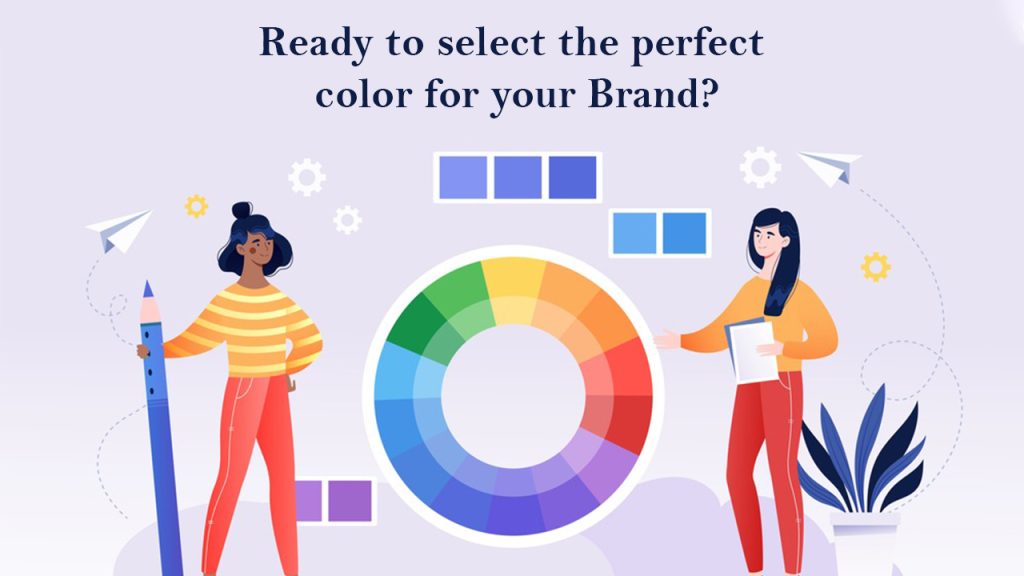Who is the unsung hero of your brand identity? Brand Colour.Â
Colour is much more than just aesthetic for your brand, it’s a very powerful tool to convey the message of the brand and the value it holds. The following blog talks about the psychology behind the brand colour, what power it has and how we can choose the right brand colour.Â
Table of Contents
ToggleWhat is Colour Psychology?
Colour Psychology is knowing about the influence of colour on the behaviour of humans and their perception. Every colour has a different story to tell.
For instance, Red creates urgency, green is the symbol of nature, white is used to show peace and blue is used for professionalism. Brands can stir their message with their longing image by understanding the psychology behind colour.
Colour Psychology Impacts on the Behaviour of the Consumer
The world of colour plays a very significant role in consumer behaviour and purchasing decisions. Studies show that up to 85% of consumers consider colour as a primary reason for buying a product.
With the help of colour, brands can attract the customer’s attention, convey the brand message and create differentiation among their competitors.
For example: fast-food chains usually go with red or yellow colours to create a sense of urgency, Similarly, luxury brands use black and gold to imply sophistication and exclusivity.Â
Role of colours in Brand Identity
1. Brand Identify
What if your brand is remembered because of your brand colour. The colour reflects values and personality of the brand, For example, children can opt for cheerful and bright colours.
An organic brand chooses green to emphasise nature and healthy products. The colour you choose should reflect the brand message and should be consistent across all touchpoints.Â
2. Brand Recognition
What if the brand is recognised because of colour. Consistent use of the same colour throughout all visibility helps brands get recognised easily.
When we talk about Coca-cola, the colour pop-up in our mind is red, for starbucks you remember their green logo.
If brands will maintain the consistency of colour across logo, website, packaging advertising and marketing creates strong brand presence.
Brand choice of colour will help brands stand out in the crowded market of cut-throat competition.Â
3. Brand Loyalty
What if the consistent use of colour across all marketing material will build trust and loyalty. Consumers tend to return to the brand who feel familiar and reliable and colour plays an important role in building the same.
For instance: Apple’s minimal design and consistent use of white and silver across all products and marketing.Â
“Brand colour creates emotional connection”
How to Choose the Right Brand Colour

1. Understand the Colour Palette
Before even choosing the right brand colour you need to first focus on understanding the implied meaning of different colours, so when customers interact with your brand in any shape or form they are quick to perceive the value you want to communicate.
For Instance: Use yellow to communicate cheerfulness, optimism, and motivation. Use red to show alert, urgency, boldness, and aggressiveness.Â
2. Sync with Brand Values
Every brand has a vision, mission and value. It is very important that the market should perceive your values the way you want them to communicate and for that having alignment with the colour is the foremost thing.
For eco-friendly green colour is appropriate, and gold and black is for elegance. The colour you choose should resonate with the brand values.Â
3. Keep your Target Audience in Mind
You should always take into consideration your target audience. Research the choices, preferences and cultural associations with brand colour.
For instance: White is considered pure in Western culture whereas it may represent mourning in some Eastern cultures.Â
Additionally, the age and gender of your target audience will also influence the colour preference.Â
Younger Audiences may prefer bright, bold, vibrant colour, while the Old generation may prefer a subtle, white, minimal colour palette.Â
4. Competitors Analysis
Before coming to a conclusion, brands should do a SWOT analysis and competitive analysis and identify the unique colour.
Understand the colour palette of competitors in the market and choose the colour which sets you apart.Â
5. Versatile Thinking
While choosing the colour for your brand do not rigid the thoughts to only for packaging or logo. Be open-minded and consider every platform and touchpoint your audience might be in.
6. Reflect the Brand Personality
Just like you make an impression of the person based on their personality and how they interact with you on your first meet, similarly audience will also remember brands based on their first interaction, and to make the interaction rememberable brands must choose a colour that aligns with the characteristics, in order to get audience attention.Â
Conclusion:
To conclude, colour choice is much more than aesthetic choice, it is a tactical decision which can overpower the behaviour of consumers, crafting of brand identity and building loyalty.
Understanding the psychology behind colour by considering the values of the brand, their audience, the colour harmony and their market competitors, will help brands decide the brand colour and ultimately create a strong brand identity.Â





